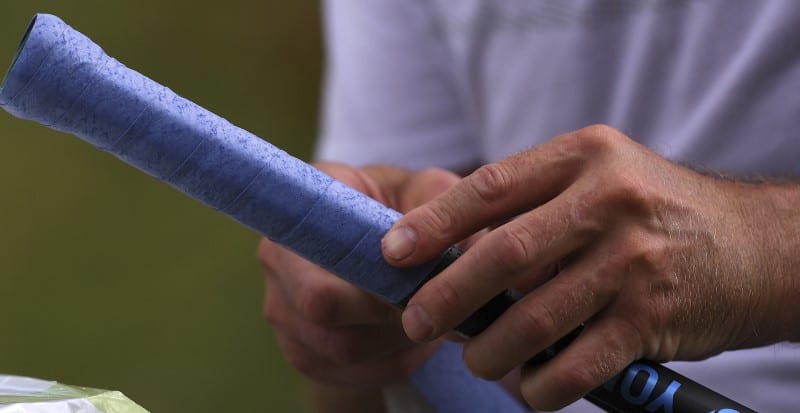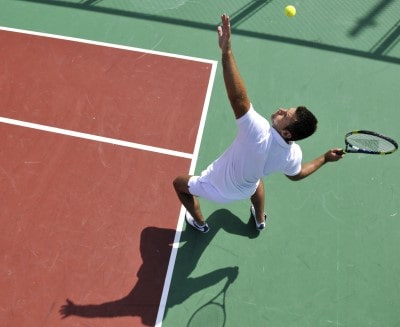The grip is extremely important to any tennis player. In fact, it may easily be one of the most underestimated aspects of the tennis racquet by many beginners.
Understanding the purpose of tennis grips and their differences is essential if you want to make sure you got every point covered when looking for ways to improve your game.
So what is the difference between a base grip and an overgrip?
Base grips come with the racquet. They provide better cushioning and are more durable. Base grips can be either synthetic or leather. Overgrips, on the other hand, are significantly thinner and provide a fresh surface for additional tackiness and moisture absorption. Overgrips are made of clothlike material and less durable.
This is a topic with many interesting caveats, and it almost asks for a certain outside of the box thinking mentality. Below I cover everything you need to know about the differences between grips and overgrips.

What Is the Difference Between a Base Grip and an Overgrip?
Base grips and overgrips are very different and should not be confused.
Purpose
The main difference between a base grip and an overgrip is that the base grip comes with the racquet. Racquets do not come with an overgrip.
The base grip is placed directly on to the racquet’s handle and provides better grip and comfort. The base grip makes the handle a little more tacky or grippy. This means that you will be less likely to have the racket slip out of your hand.
The second advantage of using a base grip is that it protects your hand on two levels. First, by using the grip, you will be able to play for extended periods of time without that resulting in blisters.
And second, the base grip also serves as a protective layer that provides moderate levels of cushioning and shock absorption.
However, the base grip also has another purpose. You see, while you are playing, you cannot afford the time to be looking at the racket and how you are holding it. The base grip will maintain the form or the bevels of the racquet. This allows tennis players to easily and seamlessly find their backhands, forehands, or volleys without looking at the racquet.
The overgrip, on the other hand, is exactly what it sounds like—it goes over the (base) grip. I know it may sound like a stretch, but this is the easiest way to remember the difference between a grip and an overgrip.
Overgrips are placed on top of the base grip in a similar fashion. In a way, they provide much of the same functions the base grips do.
Overgrips are thinner and provide less cushioning compared to base grips. Usually, they are between 1/4 and 1/2 the thickness of the base grip. Their main function is to further enhance the functions and performance of the base grip.
There are two main types of different overgrips depending on their functions:
- Tacky overgrips: These are designed to add extra tackiness in order to improve your grip and reduce the chances of the racquet handle slipping away from your hand.
- Absorbent overgrips: They provide extra sweat absorption and are the perfect solution for players with sweaty hands. Oftentimes these are perforated—this improves moisture absorption.
Overgrips can also be used to increase the size of the grip.
Overgrips can be found in many different colors, though white is the most popular. In contrast, base grips are usually black, gray, or sometimes blue. There are also brown base grips, which are made of leather.
Materials
Base grips are frequently made of either a very durable synthetic material or leather. On the other hand, overgrips are usually made of soft, cloth-like material. To my knowledge, there are no leather overgrips.
Durability
Overgrips are not as durable as base grips. They have to be changed frequently as they wear out a lot faster. Overgrips are changed every one to two weeks, depending on how often you play. Sometimes they can start to break down even after 1 to 10 hours of gameplay.
Although significantly more durable, base grips will also slowly wear out with time. Even if you are always using new overgrips, the base grips will still continue to wear out.
Overgrips can also start leaving a little residue over the base grip, which can further reduce the base grip efficacy.
Compared to overgrips, base grips are changed less frequently. The base grip should be changed at least once every six months or so, depending on how often you play. (In certain cases, this timeframe can be reduced down to 2 weeks.)
Replacement
The replacement of the overgrip is usually easier and cheaper compared to the replacement of the base grip.
Below I have included two excellent instructional videos. The first covers the proper way to replace a base grip, and the second covers the aspects of replacing an overgrip.
Make sure to check them out to see both the differences and similarities between replacing a base grip and an overgrip.
Replacement Grip vs. Overgrip
Replacement grips are designed to replace the base grip when it wears out. In other words, replacement grips and base grips should be considered the same thing as they serve the same purpose.
They are applied directly to the handle of the racquet. Replacement grips are mostly synthetic, but there are leather options available, too.
Compared to overgrips, replacement grips are thicker and more durable. They consist of a top layer that provides good levels of tackiness, a medium gel or foam layer for cushioning, and an adhesive layer which is applied directly to the racquet’s handle.
(Some overgrips may have adhesive on one of their ends, too, though.)
Overall, replacement grips are more expensive than overgrips.
Two Overgrips vs. a Replacement Grip
Interestingly enough, if you have been playing tennis for long enough sooner or later, you will stumble upon players that use two overgrips instead of a replacement grip and an overgrip.
First, let me say that there are no rules that have been set in stone here. It is all about what grips and grip setups feel comfortable to you while playing.
In other words, there is nothing inherently wrong about using two overgrips. But is it worth it?
The difference between two overgrips and a replacement grip is that it slightly changes the racquet’s weight distribution, making it more head heavy. The grip size will also be smaller.
The upside is that the grip may feel better to some players, and the bevels will be easier to feel.
The downsides of using two overgrips, though, are that you will be able to feel the impact of the tennis ball and the subsequent vibrations a lot stronger. Overgrips can be up to four times thinner than a base grip. This could tire your hands faster. The reduced padding may also cause more blisters.
Should You Use a Base Grip or an Overgrip?
Normally you should have at least one kind of tape on your racquet. But there are several very common tape combinations are:
- Base grip + Overgrip
- Overgrip + Overgrip
- Overgrip
The most popular combination is the base grip with an overgrip. The majority of players seem to find this one most comfortable and convenient. Usually, it is cheaper to change overgrips as they wear out than playing without an overgrip and having to replace the base grip.
With that being said, some players do prefer to play without the overgrip. So you will have to keep an open mind and experiment to see what feels best for you.
Other tennis players have come to love how the racquet feels when they are using two layers of overgrip. Despite there being some disadvantages to it, it is a cheap and easy way to provide yourself with some decent level of grip. In addition to that, it is not unheard of players using three layers of overgrip as well. (In fact, you can put as many layers of overgrip as you want.)
A single layer of overgrip is also a possible scenario. However, this will be even harder on your hands, and the vibrations will be powerful. This setup is usually not recommended.
And just to make sure I have covered every aspect, you could technically you can play without using any grip tape whatsoever. However, this is not recommended as you will get a lot of blisters, your hand and shoulder will be a lot more tired, and you will not have a good hold of the racket if your hands sweat.
The racquet will dig into your hand, which could hurt it, and the vibrations will be extremely strong.
If you have elbow and shoulder problems, then it is almost mandatory to have a good base grip (or replacement grip) and a good overgrip. You want to have as much cushioning as possible in order to reduce the impact on your elbow and shoulder. (Other aspects of your racquet like the string tension may also need to be adjusted in this case.)
Overall, if your base grip is in good condition, you just need to put an overgrip on top. A lot of the pros use a leather grip with an overgrip to deal with the sweat. So this may be a good long-term goal. In the end, it all boils down to personal preferences and feel.
Read our full review on Best Tennis Grips.


